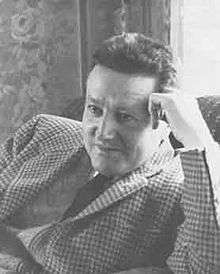William Herbert Sheldon
| William Herbert Sheldon | |
|---|---|
 | |
| Born |
November 19, 1898 Warwick, Rhode Island |
| Died |
September 17, 1977 (aged 78) Cambridge, Massachusetts |
| Occupation | Psychologist and eugenicist |
William Herbert Sheldon, Jr. (November 19, 1898 – September 17, 1977) was an American psychologist and numismatist. He created the field of somatotype and constitutional psychology that tried to correlate body types with behavior, intelligence and social hierarchy illustrated by his Ivy League nude posture photos.[1] However, his work is generally dismissed by modern researchers.[2]
Early life and education
Sheldon was born in Pawtuxet, Rhode Island on November 19, 1898 to William Herbert Sheldon, Sr., a naturalist and animal breeder, and Mary Abby Greene, a village midwife. His godfather was the noted psychologist and philosopher, William James. He graduated from Warwick Veterans Memorial High School in 1915 and attended Brown University. After graduating, he worked in a range of fields before studying for his master's degree at the University of Colorado. Sheldon attended the University of Chicago and earned his Ph.D. in 1925. He taught psychology at the University of Chicago and at the University of Wisconsin. He attended the University of Chicago Medical Center, receiving his M.D. in 1933.[3][4]
Gaining a two-year fellowship in Europe allowed him to study under Carl Jung, and visit Sigmund Freud and Ernst Kretschmer. After Europe, he moved to Harvard University in 1938. He served in the Army Medical Corps at lieutenant colonel rank in the Second World War.[4]
From 1947 to 1959 he was Director of the Constitutional Laboratory at the Columbia University College of Physicians and Surgeons. He became a professor of medicine at the University of Oregon Medical School in 1951.[4][5]
Work
In psychology, he developed a new version of somatotypology by classifying people into endomorphic, mesomorphic, and ectomorphic, based on many photographs and measurements of nude figures at Ivy League schools.[4] Ron Rosenbaum writes: "He believed that every individual harbored within him different degrees of each of the three character components. By using body measurements and ratios derived from nude photographs, Sheldon believed he could assign every individual a three-digit number representing the three components, components that Sheldon believed were inborn -- genetic -- and remained unwavering determinants of character regardless of transitory weight change. In other words, physique equals destiny."[1]
In numismatics, he authored Early American Cents and later revised that work within Penny Whimsy (these were the most exhaustive catalogues of the varieties of early American large cents at that time). The Sheldon variety list for Early American Cents is still in use today. He also developed the "Sheldon scale" that graded coins on a numeric basis from 1 to 70, which is still standard among American numismatists.[6]
Death
Sheldon died in his office at the Biological Humanics Center in Cambridge, Massachusetts on September 17, 1977.[5]
Publications
- Sheldon, William H. ♦ Psychology and the Promethean Will ♦ Harper & Brothers, 1936
- Sheldon, William H. ♦ The Varieties of Human Physique (An Introduction to Constitutional Psychology) ♦ Harper & Brothers, 1940
- Sheldon, William H. ♦ The Varieties of Temperament (A Psychology of Constitutional Differences) Harper & Brothers, 1942
- Sheldon, William H. ♦ Varieties of Delinquent Youth (An Introduction to Constitutional Psychiatry) Harper & Brothers, 1949
- Sheldon, William H. ♦ Atlas of Men ♦ Harper and Brothers, 1954
- Sheldon, William H. ♦ Early American Cents, 1793–1814 ♦ Harper & Brothers, 1949
- Sheldon, William H. ♦ Penny Whimsy ♦ Harper & Row, 1958
See also
References
- 1 2 Ron Rosenbaum (1995-01-15). "The Great Ivy League Nude Posture Photo Scandal". New York Times. Retrieved 2008-03-11.
- ↑ "Nude Photos Are Sealed At Smithsonian". New York Times. January 21, 1995. Retrieved December 1, 2011.
Later, other photographs were taken by W. H. Sheldon, a researcher who believed that there was a relationship between body shape and intelligence and other traits. Mr. Sheldon has since died.
- ↑ Margaret Alic (6 April 2001), "Sheldon, William Herbert (1898-1977)", Encyclopedia of Psychology
- 1 2 3 4 Richard N. Walker (1978). "W. H. Sheldon" (PDF). Nature journal in Psychiatric Bulletin. Retrieved 2011-12-07.
- 1 2 "William H. Sheldon, 78. Correlated Physiques and Traits of Behavior. Headed Research Center". The New York Times. September 18, 1977. Retrieved 2007-07-21.
Dr. William Herbert Sheldon, a psychologist and researcher in correlating human biology and physique with social behavior, died Friday of a heart ailment at his office at the Biological Humanics Center in Cambridge, Massachusetts. He was 78 years old.
- ↑ Grading Coins
Further reading
- Gardner, Theories of personality (John Wiley & Sons Inc, 1959), pp. 336-377 (Sheldon's constitutional psychology.) - includes biography of Sheldon
- Physique as Destiny: William H. Sheldon, Barbara Honeyman Heath and the Struggle for Hegemony in the Science of Somatotyping
- "The varieties of Temperament", Harper & Brothers Publishers, 1942. downloadable versions: https://archive.org/details/TheVarietiesOfTemperamentAPsychologyOfConstitutionalDifferences